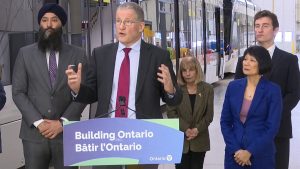Is it realistic to conclude that a shift to public transit is essential because the general public cannot afford a car?
I will leave it to the reader to draw his or her own conclusion.
Moreover, it is worthwhile to remember that in many cases, municipalities have a much cheaper option than a significant investment in new transportation infrastructure. For instance, the municipality should consider whether it can make much more efficient use of the existing municipal infrastructure.
Municipal road systems serve as a case in point. One option that would reduce traffic congestion in many large cities would be to convert downtown roads to one-way streets.
Such a step allows traffic lights to be co-ordinated, which reduces the stop-and-go nature of inner-city driving, which in turn speeds the flow of traffic through the downtown area. Hamilton, Ont. has one-way streets and I find that it does work well moving traffic through the downtown.
The cost of such a conversion is relatively cheap in comparison to the cost of building expensive light rail systems.
Another option is to consider design alternatives that permit more efficient use of land space, which thereby reduces the capital cost of new facilities.
Investment in transportation infrastructure provides a good illustration of the range of competing policy objectives that are implicit across almost the full range of municipal government expenditure, particularly with respect to construction.
A decision not to build a light rail transit system almost invariably implies some other form of financial commitment of corresponding scale, such as the construction or improvement of a road. Such alternate expenditures can carry with them as much in the way of risk as the original option.
Also, the selection of any of the competing options carries with it numerous social and economic implications that go far beyond the actual dollar expenditure required.
To many citizens, further expenditure on roads is inherently wasteful.
They argue that government should force the public to move away from private transportation to public transportation. Others go even further, any means to promote what they broadly conceive as being “development” is wrong-headed because development is not “environmentally sustainable.”
The most extreme advocates of this school go as far as to suggest that cities and even entire countries need to downsize radically to protect the environment.
Thus, any expenditure on developing capital infrastructure is in itself wrong.
Yet, the reality is that populations are rising. People must have jobs and must be able to commute to them from home.
As the economy changes, outdated businesses must be replaced by new. If municipal governments fail to accommodate these changes they will leave the next generation with an enormous burden to discharge.
Another discussion that should take place before expensive financial commitments are made is whether there is truly a sufficient benefit to the municipality to justify an expenditure.
Staying with the transportation theme, many municipalities have invested heavily in recent years in supporting alternate forms of transportation such as bicycles.
Balancing cost and benefit in relation to paying for bike lanes is particularly controversial. Proponents of such transportation argue with good reason that it is healthy and environmentally friendly.
Critics point out that bicycle routes carry far fewer passengers than other forms of transportation, do not provide in any way for commercial transportation, and are not well suited to the needs of many municipal residents, particularly the elderly, those with small children and the disabled.
Common sense would seem to indicate that transportation expenditures should take into account established patterns of transportation usage and reliable data indicating how those patterns might change if a proposed transportation initiative is introduced.
The point to all this is fairly simple: strategic procurement is not about coming up with creative ways to spend money.
Stephen Bauld is a government procurement expert and can be reached at swbauld@purchasingci.com.
Some of his columns may contain excerpts from The Municipal Procurement Handbook published by Butterworths.










Recent Comments
comments for this post are closed